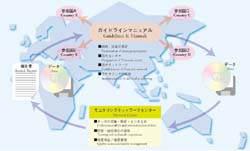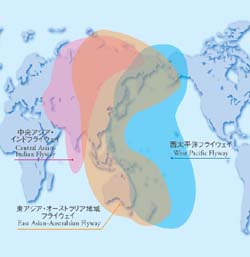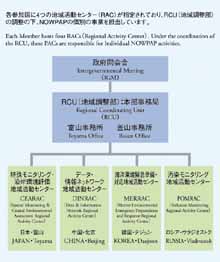North-East
Asian Subregional Programme for Environmental Cooperation (NEASPEC)
Six countries in the Northeast Asian region (Japan, Republic
of Korea, China, Russia, Mongolia, and Democratic People’s
Republic of Korea) have held the Meeting of Senior Officials
on Environmental Cooperation in Northeast Asia every year
to exchange opinions and information to build a regional cooperative
relationship toward solving environmental problems at both
a global and regional level through cooperation transcending
national borders.
Under this meeting, to encourage environmental cooperation
in the region, the countries are advancing the North-East
Asian Subregional Programme for Environmental Cooperation
(NEASPEC), which includes training and data collection for
pollution-abatement measures and conservation programs for
large mammals and migratory birds.
Acid Deposition Monitoring Network in East Asia (EANET)
In order to address the acid deposition problem, which is a transboundary environmental problem, the activities of the Acid Deposition Monitoring Network in East Asia (EANET) had been implemented with participation by thirteen East Asian countries (Cambodia, China,
Indonesia, Japan, Lao PDR, Malaysia, Mongolia, Myanmar, the Philippines, the Republic of Korea, Russia, Thailand, and Viet Nam). The network conducts monitoring with harmonized methods in all countries, to promote common understanding on the current state of acid
deposition ultimately aiming at counteraction including emission control on a scientific basis and under international collaboration.
The Network started its full-fledged activities in January 2001, following the Joint Announcement issued at the Second Session of the Intergovernmental Meeting on EANET.
Acid Deposition Monitoring Network in East Asia (EANET)

 up
up
Asia-Pacific Migratory
Waterbird Conservation Strategy
Since 1996, the conservation of migratory waterbirds and
their habitats in the Asia-Pacific region has been promoted
through the Asia-Pacific Migratory Waterbird Conservation
Strategy, which is an international cooperative initiative.
The Strategy defines the current state of NGO activities
and bilateral and multilateral agreements between governments,
confirms the problems that have emerged in the conservation
of migratory waterbirds and their habitats, and establishes
the goals and activities involved for settlement of problems
and greater international cooperation. Under the Strategy,
three networks of internationally important sites for migratory
shorebirds, cranes and Anatidae have been developed. Numerous
activities such as organization of symposiums and training
courses as well as information exchanges have been undertaken
at network sites. The Ministry of the Environment has actively
supported the Strategy and three flyway networks in cooperation
with NGOs and relevant governments in the region.
Major Waterbird Flyways in the Asia-Pacific Region

 up
up
Northwest Pacific Action
Plan (NOWPAP)
Regional Sea Programs have been implemented under UNEP initiative
for the environmental protection of sea areas shared by several
countries. In 1994, NOWPAP was adopted by Japan, China, Russia
and the Republic of Korea for the Sea of Japan and the Yellow
Sea.
In 1999, the Northwest
Pacific Region Environmental Cooperation Center (NPEC)
was designated as the Regional Activity Center (CEA-RAC),
and in 2004 a co-hosted Regional Coordination Unit in Toyama
and Pusan functioning as a secretariat of NOWPAP was established.
The Ministry of the Environment will continue to promote this
plan actively.
Meet the NOWPAP Family

The Asian Network for Prevention of Illegal Transboundary Movement of Hazardous Wastes
For the purpose of environmental protection,
transboundary movement of hazardous wastes is controlled
by the Basel Convention and the Waste Management Law in
Japan. In particular, transboundary movement in the Asian
regions is increasing rapidly along with the increase in
demand for resources, and environmental problems caused
by illegal transboundary movement of wastes and scrap are
a major concern in the region. In this regard, the Government
of Japan has proposed the establishment of the Asian Network
for Prevention of Illegal Transboundary Movement of Hazardous
Wastes, which was agreed by the representatives from 9 Asian
Parties to the Basel Convention in a Workshop held in December
2004, in Tokyo. The aims of the Network are to facilitate
the exchange and dissemination of information on transboundary
movements of hazardous wastes in Asian countries, to assist
participating countries in formulating appropriate legislative
response to such movements under each country’s system as
required by the Convention, and to provide useful information
that can contribute to capacity development for the implementation
of the Basel Convention.

